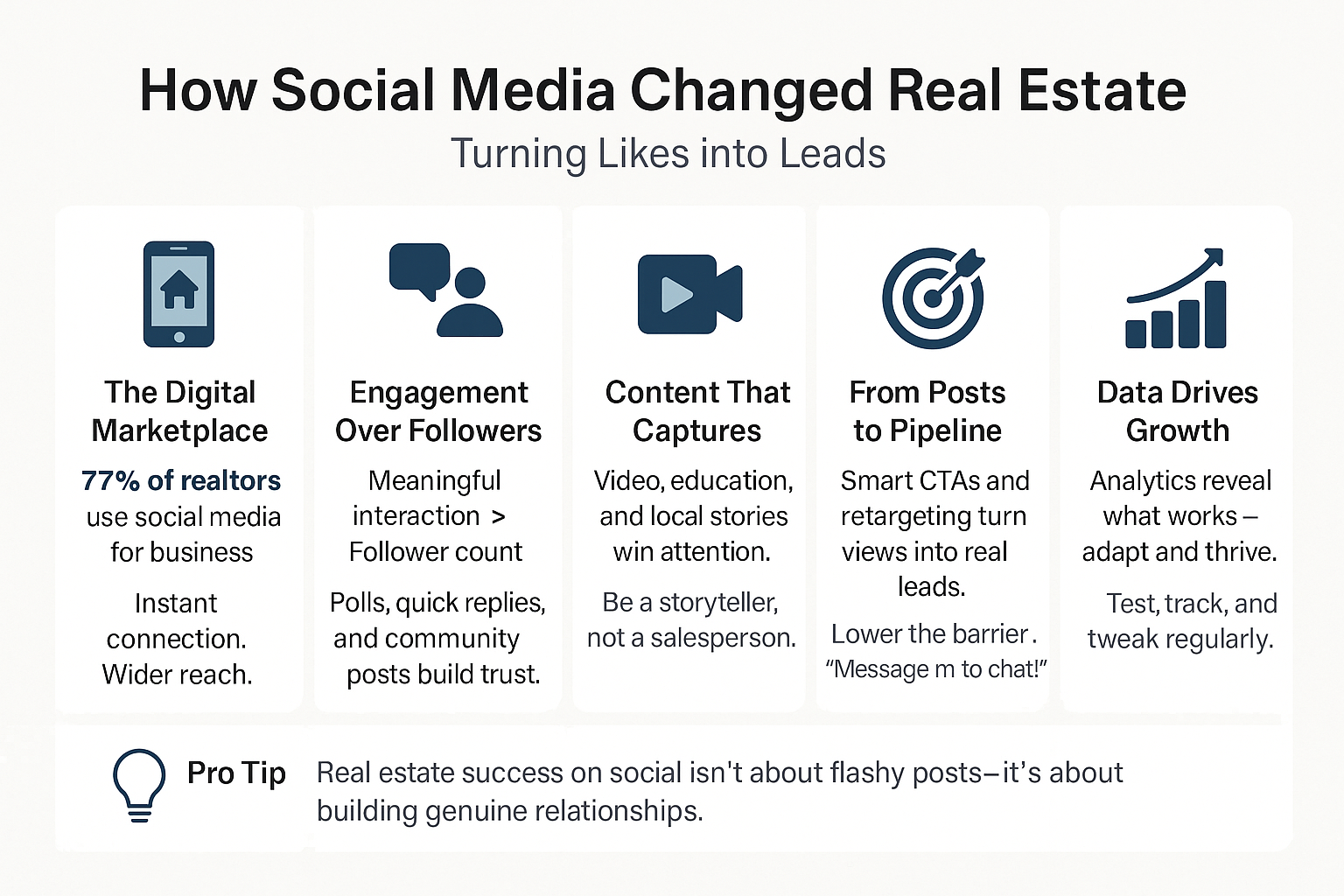Table of Contents
- 1 How Social Media Changed Real Estate
- 2 Beyond Followers: Why Quality Engagement Matters
- 3 Creating Content People Want
- 4 From Posts to Pipeline: Generating Real Leads
- 5 The Power of Analytics and Adaptability
- 6 Tapping Into Video, Testimonials & Local Expertise
- 7 Pitfalls & Peaks: Real-Life Social Success Stories
- 8 Where Social Media Marketing for Real Estate Is Headed
How Social Media Changed Real Estate
The transformation of real estate marketing thanks to social media cannot be overstated. Decades ago, a successful agent needed to master handshakes, print ads, and networking events. Today, the digital world is the new marketplace, with billions of users scrolling through listing photos, neighborhood reviews, and home-buying tips from their phones. According to the National Association of Realtors, 77% of realtors use social media for business. The platforms, from Facebook to Instagram to TikTok, have evolved to offer tools explicitly built for showcasing homes, gathering leads, and interacting with prospective clients in real-time. This means agents have access to a broader network and the ability to communicate instantly—making it easier to remain top-of-mind when buyers and sellers are ready to act.
However, the leap from scrolling to showing isn’t automatic. With more agents vying for attention online, simply posting a flyer isn’t enough. Effective marketing is about fostering familiarity and trust over time. Seeking the guidance of real estate marketing experts helps agents go far beyond the basics. These professionals provide blueprints for transforming passive online audiences into engaged communities and actual clientele. The ultimate goal is to ensure those digital connections result in new listings, contracts, and closings—not just likes or fleeting engagement.

Beyond Followers: Why Quality Engagement Matters
Chasing a massive follower count can be a distraction, blinding agents to the true potential of connection. While a large following may look impressive, research shows that sales and business relationships in real estate are driven not by numbers but by trust and meaningful back-and-forth. Posts with interactive elements—such as open-ended questions, comments, or polls—are up to 67% more likely to generate direct inquiries or lead conversions than static, one-way announcements.
- Prompt responses: Responding to questions and comments within minutes, rather than hours or days, accelerates the know-like-trust cycle. It signals real accessibility and expertise.
- Active participation: Launching interactive surveys, “this-or-that” polls on home features or neighborhood preferences, and encouraging advice-seeking DMs turns followers into active participants in the brand’s story.
- Consistent community content: Integrating birthday wishes, new homeowner celebrations, and regional updates gives the feed a personal, welcoming touch.
These practices do more than fill the comments— they create lasting connections. Clients who feel recognized and valued online are much more likely to reach out when it’s time to buy, sell, or refer a friend.
Creating Content People Want
In a world flooded with endless scrolling and image overload, capturing people’s attention—and concern—requires content that stands out. The key difference between being remembered and forgotten is relevance. Social users want information that feels crafted for them: insights that teach, local favorites that entertain, and stories that make them believe “I can see myself there.” Simply put, real estate pros need to become master storytellers and educators.
- Education-first posts: Share short videos, quick reels, or carousels explaining common real estate pitfalls, mortgage basics, and cost-saving tips for homeowners and sellers.
- Community immersion: Take virtual viewers through a locally loved farmer’s market or review a new school or park. Showcasing neighborhood charm paints a complete lifestyle picture beyond the property walls.
- Stories from real people: Featuring client journeys—like a young couple’s first purchase—builds relatability and highlights results in a way that feels far less sales-oriented and much more aspirational.
Nearly two-thirds of consumers want to establish a direct relationship with brands and professionals online. In the real estate industry, content that listens, responds, and encourages participation helps to build strong, lasting relationships. Consistently delivering genuine content that resonates with the audience can turn a modest social media presence into a powerful lead generator.
From Posts to Pipeline: Generating Real Leads
While vanity metrics such as likes and views may provide a temporary boost, the true strength of social media marketing lies in its ability to drive your business pipeline. Research on social selling shows that agents who intentionally guide their online audiences with clear next steps can generate up to 45% more new business opportunities. Every feed post, story, or message serves as an opportunity to bring connections closer to a handshake, a showing, or a signed agreement.
- Natural CTAs: Rather than hard-sell tactics, invite prospects gently—“Message me for personalized listings” or “Let’s chat about your home’s value.” Lower the barrier to engagement, making outreach feel easy and worthwhile.
- Use tech tools: Lean into built-in scheduling, inquiry forms, or single-tap contact links on platforms like Facebook and Instagram, allowing prospects to reach you at their highest moment of interest.
- Strategic retargeting: Establish campaigns to reconnect with prospects who engage with your videos or guides. Send timely reminders or value-driven updates to stay top-of-mind and encourage action.
A steady stream of value-focused CTAs transforms general interest into genuine prospects, driving up the number of conversations that turn to business.
The Power of Analytics and Adaptability
Social analytics dashboards are treasure troves for serious agents. They reveal who’s engaging, what topics spark debates, and what media formats lead to shares or saves. Intelligent agents dedicate time weekly to check their reach, engagement, click-through rates, and other vital stats, pivoting quickly when content or strategies stall. Adaptability is now a key differentiator in highly competitive markets.
Don’t be afraid to test frequently—one month might be dedicated to video tours, the next to testimonials or neighborhood guides. Track which posts inspire DMs, which get bookmarked, and which spur conversation. These insights reveal what customers are genuinely interested in and foster continual growth. Long-term, data-driven experiments breed creative, community-focused social strategies that future-proof your digital presence.
Tapping Into Video, Testimonials & Local Expertise
Video content rules the social world because it blends entertainment, authenticity, and authority. Buyers feel they can “meet” an agent before ever setting foot in a showing. Fast-moving platforms favor real, unfiltered moments: walk-throughs with commentary, event highlights, or quick market navigation tips. HubSpot reports that 88% of users are convinced to take action after viewing a brand’s video, underlining the power of seeing faces and hearing stories.
- Unscripted testimonials: Encourage buyers and sellers to share stories in their own words. These narratives cut through sales resistance and build substantial reputational capital.
- Show up locally: Go live at charity events, take followers behind the scenes in new developments, or share hidden gem eateries—making your expertise and heart for the community visible and memorable.
This blend of video and local content makes your brand not just another face in the feed but part of the everyday fabric of the neighborhood—an advisor and neighbor, not just an agent.
Pitfalls & Peaks: Real-Life Social Success Stories
Success on social media comes from a willingness to experiment, learn, and adapt. Many top-producing agents today will openly discuss posts that flopped and campaigns that went viral. For example, agents who replaced repetitive listing alerts with “inside scoop” series—such as a weekly guide on living in a particular town or myth-busting market facts—often find that engagement and web traffic quickly climb. Free “Ask Me Anything” sessions via Story features allow agents to demonstrate expertise and foster relationships with motivated buyers and sellers not ready for a call or appointment.
- Staying consistently human by responding individually and presenting a trustworthy, authentic brand identity increases impact.
- The most common error is using social media as a billboard rather than a place for genuine connection and dialogue.
- The most significant wins come from highlighting relationships, sharing value, and openly inviting feedback from the audience.
The willingness to apply lessons learned—whether from failure or success—differentiates between a transient presence and a community anchor.
Where Social Media Marketing for Real Estate Is Headed
The evolution of social media marketing in real estate is accelerating. Artificial intelligence will soon personalize content feeds and automate responses, while augmented reality and virtual tours will become standard, enhancing buyer experiences. Analytics will continue to advance, delivering pinpoint targeting for agents seeking niche markets. Remaining educated about current real estate news and shifts helps agents adapt their strategies and serve their audiences at the highest level.
The most effective social agents of tomorrow will blend trustworthy conversation, creative content, and neighborhood knowledge to create a sense of genuine relationships. As trends shift, returning to fundamentals—fostering authentic connections and delivering value—will always remain the best way to turn likes into leads and followers into lifelong, happy clients.




